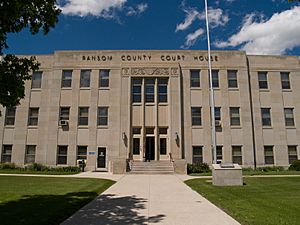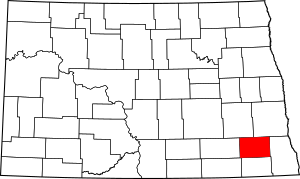Ransom County, North Dakota facts for kids
Quick facts for kids
Ransom County
|
|
|---|---|

Ransom County Courthouse
|
|

Location within the U.S. state of North Dakota
|
|
 North Dakota's location within the U.S. |
|
| Country | |
| State | |
| Founded | January 4, 1873 (created) April 4, 1881 (organized) |
| Named for | Fort Ransom |
| Seat | Lisbon |
| Largest city | Lisbon |
| Area | |
| • Total | 864 sq mi (2,240 km2) |
| • Land | 862 sq mi (2,230 km2) |
| • Water | 1.4 sq mi (4 km2) 0.2% |
| Population
(2020)
|
|
| • Total | 5,703 |
| • Estimate
(2022)
|
5,640 |
| • Density | 6.601/sq mi (2.5485/km2) |
| Time zone | UTC−6 (Central) |
| • Summer (DST) | UTC−5 (CDT) |
| Congressional district | At-large |
Ransom County is a county in the U.S. state of North Dakota. As of the 2020 census, the population was 5,703. Its county seat is Lisbon.
Contents
History
The Dakota Territory legislature created Ransom County on January 4, 1873. It was so named due to its military fort, which had been named Fort Ransom for Civil War veteran Major General Thomas E.G. Ransom. The fort had operated between 1867 and 1872. The county was not organized at that time, nor was it attached to another county for administrative or judicial purposes. Its proposed boundaries were altered two times during 1881. On April 4, 1881, the county government was effected. The county's area was again reduced in 1883 when Sargent County was created. Ransom County has retained its present configuration since that time.
Geography
The Sheyenne River meanders through Ransom County. The county terrain consists of rolling hills, dotted with lakes and ponds in its western part. The area is largely devoted to agriculture. The terrain slopes to the east and south; its highest point is on the north boundary line near its northwestern corner, at 1,421 ft (433 m) ASL. The county has a total area of 864 square miles (2,240 km2), of which 862 square miles (2,230 km2) is land and 1.4 square miles (3.6 km2) (0.2%) is water.
Major highways
Adjacent counties
- Cass County - northeast
- Richland County - east
- Sargent County - south
- Dickey County - southwest
- LaMoure County - west
- Barnes County - northwest
Protected areas
- Browns Ranch
- Fort Ransom State Historic Site
- Fort Ransom State Park
- Nature Conservancy's Sheyenne Delta
- North Country Trail
- Pigeon Point Reserve
- Sheyenne National Grassland (part)
- Sheyenne State Forest
Lakes
- Lone Tree Lake
Demographics
| Historical population | |||
|---|---|---|---|
| Census | Pop. | %± | |
| 1880 | 537 | — | |
| 1890 | 5,393 | 904.3% | |
| 1900 | 6,919 | 28.3% | |
| 1910 | 10,345 | 49.5% | |
| 1920 | 11,618 | 12.3% | |
| 1930 | 10,983 | −5.5% | |
| 1940 | 10,061 | −8.4% | |
| 1950 | 8,876 | −11.8% | |
| 1960 | 8,078 | −9.0% | |
| 1970 | 7,102 | −12.1% | |
| 1980 | 6,698 | −5.7% | |
| 1990 | 5,921 | −11.6% | |
| 2000 | 5,890 | −0.5% | |
| 2010 | 5,457 | −7.4% | |
| 2020 | 5,703 | 4.5% | |
| 2022 (est.) | 5,640 | 3.4% | |
| U.S. Decennial Census 1790-1960 1900-1990 1990-2000 2010-2020 |
|||
2020 census
As of the census of 2020, there were 5,704 people.
2010 census
As of the census of 2010, there were 5,457 people, 2,310 households, and 1,466 families in the county. The population density was 6.33 people per square mile (2.44 people/km2). There were 2,656 housing units at an average density of 3.08 units per square mile (1.19/km2). The racial makeup of the county was 97.8% white, 0.4% Asian, 0.4% American Indian, 0.3% black or African American, 0.1% Pacific islander, 0.1% from other races, and 0.9% from two or more races. Those of Hispanic or Latino origin made up 1.2% of the population. In terms of ancestry, 54.2% were German, 36.6% were Norwegian, 9.0% were Irish, 6.9% were Swedish, 5.1% were English, and 1.6% were American.
Of the 2,310 households, 27.8% had children under the age of 18 living with them, 54.8% were married couples living together, 5.4% had a female householder with no husband present, 36.5% were non-families, and 32.9% of all households were made up of individuals. The average household size was 2.28 and the average family size was 2.89. The median age was 45.2 years.
The median income for a household in the county was $46,044 and the median income for a family was $59,973. Males had a median income of $42,380 versus $28,209 for females. The per capita income for the county was $21,995. About 7.5% of families and 9.4% of the population were below the poverty line, including 13.2% of those under age 18 and 11.6% of those age 65 or over.
Population by decade

Communities
Cities
- Elliott
- Enderlin (partly in Cass County)
- Fort Ransom
- Lisbon (county seat)
- Sheldon
Census-designated places
Townships
- Aliceton
- Alleghany
- Bale
- Big Bend
- Casey
- Coburn
- Elliott
- Fort Ransom
- Greene
- Hanson
- Island Park
- Isley
- Liberty
- McLeod
- Moore
- Northland
- Owego
- Preston
- Rosemeade
- Sandoun
- Scoville
- Shenford
- Springer
- Sydna
- Tuller
Education
School districts include:
- Enderlin Area Public School District 24
- Fort Ransom Public School District 6
- Kindred Public School District 2
- LaMoure Public School District 8
- Litchville-Marion Public School District 46
- Lisbon Public School District 19
- Milnor Public School District 2
- North Sargent Public School District 3
- Oakes Public School District 41
- Wyndmere Public School District 42
In 1905 it had 22 school districts, with 16 not having a bond. Circa 1905 the county had 2,431 students in its three high schools, five grade schools, and 75 schoolhouses.
See also
 In Spanish: Condado de Ransom para niños
In Spanish: Condado de Ransom para niños


